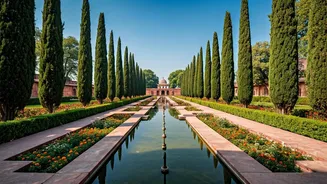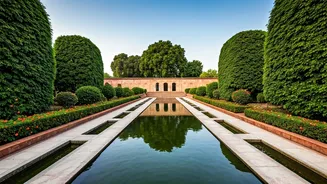A Historical Overview
Mughal Gardens, a notable facet of the Mughal Empire, were constructed during the 16th and 17th centuries. These gardens were a blend of Persian and Indian
influences, displaying a unique fusion of architectural styles. The Mughals, who were avid patrons of art and architecture, saw the gardens as symbols of power, serenity, and paradise. The gardens often featured running water, carefully planned layouts, and symmetrical designs, with a focus on creating a sense of harmony and aesthetic appeal. Their design typically incorporated elements such as fountains, pools, canals, and lush greenery, providing both visual delight and a cool respite from the heat. These gardens served not only as recreational spaces for the emperors and their courtiers but also as settings for diplomatic meetings and celebrations, illustrating their crucial role in the social and cultural life of the time.
Shalimar Bagh, Srinagar
Shalimar Bagh, situated in Srinagar, Jammu and Kashmir, stands out as one of the most stunning Mughal Gardens. Its construction, initiated by Emperor Jahangir in 1619, was dedicated to his wife, Nur Jahan. The garden's design features three terraces: the outer public garden, the central garden for the nobility, and the upper garden, reserved for the emperor and his family. Shalimar Bagh exhibits a classic Mughal layout with symmetrical patterns, terraced lawns, cascading fountains, and a canal running through the center. The garden's strategic location along the Dal Lake adds to its scenic appeal, with stunning views of the surrounding mountains. The harmonious combination of water features, lush greenery, and architectural details such as pavilions and arched gateways showcases the Mughal mastery of garden design, making it a timeless beauty.
Nishat Bagh, Srinagar
Nishat Bagh, another gem in Srinagar, was built by Asaf Khan, Nur Jahan's brother, in 1633. Positioned on the eastern side of the Dal Lake, Nishat Bagh, meaning 'Garden of Delight,' provides sweeping vistas of the lake and the Pir Panjal mountain range. The garden's layout is characterized by a series of terraces that gradually ascend, offering panoramic views. It features a unique design compared to other Mughal Gardens, with the garden's central axis slightly angled to the lake. The interplay of water channels, fountains, and diverse flowering plants enhances its beauty. Nishat Bagh's serene atmosphere and carefully designed layout demonstrate the Mughal understanding of garden design, emphasizing both aesthetic appeal and a connection with nature. It stands as a symbol of tranquility and a reminder of the Mughal Empire's architectural achievements.
Pinjore Garden, Haryana
Pinjore Garden, also known as Yadavindra Garden, is located in the town of Pinjore, Haryana. It was originally constructed by Fidai Khan in the 17th century and later renovated by Maharaja Yadavindra Singh of Patiala. The garden reflects a blend of Mughal and Rajasthani architectural styles, showcasing the adaptability of Mughal garden design. Pinjore Garden includes seven terraces, each with its unique features such as fountains, pavilions, and water channels. The use of water as a central element in the garden, along with its symmetrical layout and lush greenery, illustrates the Mughal design principles of harmony and order. The garden also incorporates features like the Sheesh Mahal and the Rang Mahal, which were designed for entertainment and relaxation. Pinjore Garden serves as a vibrant illustration of Mughal garden design, harmonizing with the surrounding landscape.
The Mehtab Bagh
Mehtab Bagh, located across the Yamuna River from the Taj Mahal in Agra, Uttar Pradesh, offers a distinct view of this iconic monument. Constructed in the early 17th century, the garden was designed to be the final viewpoint from which to admire the Taj Mahal. The garden's layout is symmetrical, with reflecting pools that mirror the Taj Mahal. Mehtab Bagh's design prioritizes a simple, yet elegant arrangement that emphasizes the beauty of the Taj Mahal. The use of flowering plants and water features creates a serene atmosphere, enhancing the view of the monument. Today, Mehtab Bagh is recognized as an integral aspect of the Taj Mahal complex, offering a unique perspective and an enduring symbol of Mughal architectural brilliance.
Humayun's Tomb Garden
The garden surrounding Humayun's Tomb in Delhi is a significant example of Mughal garden design. Built in the mid-16th century, it was the first garden tomb on the Indian subcontinent. The garden is based on the Charbagh style, which is characterized by a quadrilateral layout divided into four sections by water channels, representing the four rivers of paradise. The inclusion of walkways, fountains, and diverse trees and flowers enhance the garden’s aesthetics. The symmetrical design of the garden showcases the Mughal Emperors' interest in creating harmony and symmetry. The garden's importance is further enhanced by its association with the Humayun's Tomb, a significant architectural landmark, making it a quintessential example of Mughal design and a UNESCO World Heritage site.
Rambagh, Agra
Rambagh, situated in Agra, is often considered one of the earliest Mughal gardens in India. It was likely constructed by Babur, the first Mughal emperor. Rambagh’s design features a classical Charbagh layout with symmetrical patterns and water channels. The garden’s simple yet elegant design includes various pavilions, fountains, and waterways. Rambagh serves as a testament to the Mughals' initial architectural endeavors and their appreciation for creating serene and visually appealing spaces. The simplicity and historical significance make Rambagh a notable illustration of early Mughal design and a vital component of Agra's heritage.
Yusuf Bagh, Lucknow
Yusuf Bagh, located in Lucknow, Uttar Pradesh, is a Mughal garden that played a part in the city's rich cultural history. It features design elements inspired by the Mughal style. Although specific information about the exact construction is limited, Yusuf Bagh reflects the Mughal Empire's influence on the region, which is evident in its architectural designs, serene atmosphere, and aesthetic appeal. The use of water channels, fountains, and carefully planned layouts are features that embody the characteristics of Mughal gardens. Yusuf Bagh provides a serene environment reflecting the blend of cultures and architectural styles during the Mughal period.
Lodhi Garden, Delhi
Lodhi Garden in Delhi, while not strictly a Mughal garden, exhibits influences from Mughal design elements. The garden integrates elements from the Lodhi dynasty with Mughal architectural principles. It is renowned for its diverse historical monuments, including the tombs of Muhammad Shah and Sikandar Lodi, along with the Shisha Gumbad and Bara Gumbad. Lodhi Garden includes water features, walking paths, and expansive green areas, which harmonize with the historical structures. The garden's design represents a unique fusion of various architectural styles, providing an example of Delhi's rich cultural heritage. Lodhi Garden offers visitors a blend of history, architecture, and natural beauty.
Fatehpur Sikri Gardens
The gardens within Fatehpur Sikri, a historical city in Uttar Pradesh, exhibit Mughal architectural and design elements. Built during Emperor Akbar's reign, the city contains a variety of structures that showcase the integration of Persian and Indian architectural styles. The gardens, although not as extensive as others, feature water elements, symmetric layouts, and meticulous landscaping. The architectural designs of Fatehpur Sikri's gardens blend with the city’s complex, reflecting the Mughal Emperors' approach to art and design. These gardens provide tranquil spaces among the historical buildings, representing Mughal creativity and architectural skill.














